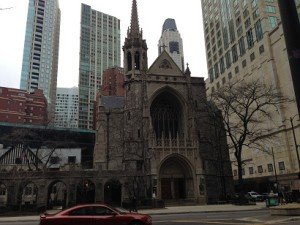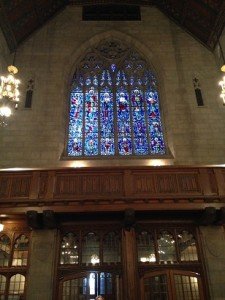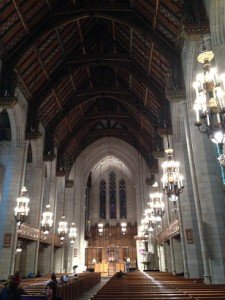You’ll find this beautiful and historic church among the towering skyscrapers on North Michigan Avenue in Chicago Illinois. The Fourth Presbyterian Church, Fourth Church, as it’s commonly referred to by congregants, has become a destination for churchgoers around the Chicago area. The church’s beautiful glow at night adds immeasurable beauty to Chicago’s downtown area.
Thank you for reading this post, don't forget to subscribe!
A Church on Chicago’s Magnificent Mile
Fourth Presbyterian Church was built in the Gothic Revival style of architecture. The church sits in the middle of Chicago’s Magnificent Mile shopping district and provides an oasis from the noise of the street. The church is noted for it’s presenting a range of musical events. Fourteen life-size statues of musicians grace the interior, setting the stage for the church’s organ and noonday concerts and for its series of jazz, classical and chamber music.
Two Churches Merge
Read more at http://chicago.metromix.com/venues/mmxchi-fourth-presbyterian-church-venue-1#F2wcAtus17Jt7mAI.99
In 1871 two churches merged to form Fourth Presbyterian Church. The Fourth Presbyterian Church of Chicago was founded in February 1871 when the congregations of Westminster Presbyterian Church and North Presbyterian Church merged. Timing however was not optimal. On October 8 of 1871, the great Chicago fire destroyed Fourth Church’s first worship site the very same night the congregation dedicated it’s new home.

During February 1874, the congregation dedicated its new facility on the northwest corner of Rush and Superior Streets. After 40 years at this location, the growing congregation and its many programs called again for a new larger church.
The new congregation worshiped at Superior and Rush for the next forty years from 1874 until 1914. It was then time again to move. The church purchased a plot of land three blocks north, on what would later become Michigan Avenue, and the cornerstone for a new place of worship was laid on September 17, 1912. This new location would eventually become North Michigan Avenue’s ” Magnificent Mile.” When the Michigan Avenue Bridge opened over the Chicago River in 1920 the neighborhood essentially grew up all around the church. Fourth Presbyterian Church is now the oldest surviving structure on Michigan Avenue north of the river
An interesting side note is that the name “Fourth” was chosen not because it was the fourth Presbyterian church to be founded in Chicago. There were several founded before it. North Presbyterian Church is one of the earliest. “Fourth was chosen because “Fourth” was the lowest number then not in use.

A Unique Church in the Heart of a City
Fourth Presbyterian Church became the home to influential pastors and wealthy congregants. Fourth Presbyterian earned both a well deserved civic and national reputation befitting its beautiful Gothic architecture.
Called “a social settlement with a spire,” the church reached out to the poor in the nearby “Little Hell” neighborhood. Fourth Presbyterian helped create the Presbyterian Hospital in 1884, and it was the catalyst for the founding of sister churches in the city’s heavy immigrant areas. The church also became much involved with social activism. In 1979 Fourth Presbyterian helped to create Atrium Village, an innovative mixed-income housing development.
The Sanctuary Organ
The current Sanctuary organ is a 1971 Aeolian-Skinner Organ, Opus 1516, with 126 ranks, numbering 6,603 pipes. It is the second largest instrument in the city (second only to the organ at the University of Chicago’s Rockefeller Chapel) and one of largest in the Midwest. Some of the existing pipe work dates back to 1914 when Ernest M. Skinner was contracted to build the first pipe organ. That organ contained 59 ranks. Among them was a stop invented by Skinner called the Kleine Erzäehler, which means “little storytellers,” a stop of which he was most proud.
See the Trips Into History articles on the links below…
The Palace Steamers of the Great Lakes
Lake Michigan and the Carl D. Bradley Sinking
Concerts and Art
Free noonday concerts take place at Fourth Presbyterian Church—in the Sanctuary or Buchanan Chapel (except when otherwise noted) from September through June and outdoors in the courtyard off Michigan Avenue, by the fountain, in July and August.
Weekday evening and Sunday afternoon concerts are also offered occasionally throughout the year.
When your travels take you to the downtown Chicago area make it a point to stop by this magnificent and unique church. Fourth Presbyterian Church is a must see during your tour of downtown Chicago. The church is located at 126 E Chestnut St, Chicago, IL.
(Article and photos copyright 2014 Trips Into History)
